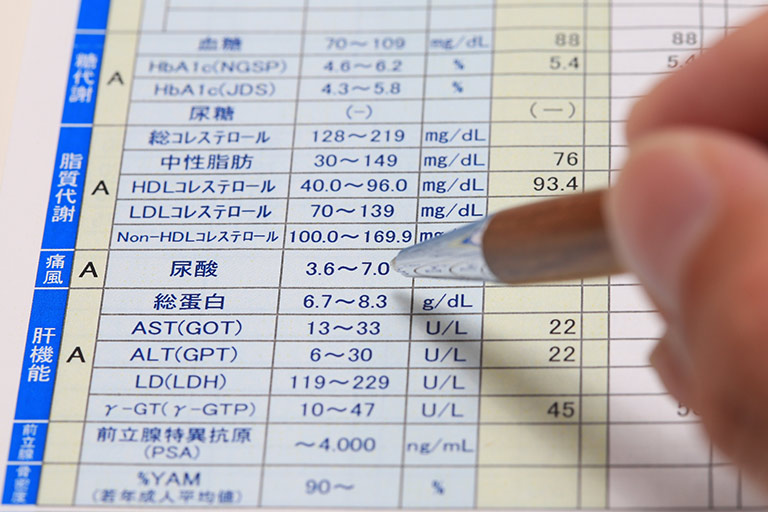Causes and Countermeasures for Hypouricemia.
Normal Values of Uric Acid

You might have seen your uric acid levels in the results of medical checkups or comprehensive medical examinations. Do you know the normal values of uric acid and the values considered to be problematic? The following describes the normal value of uric acid and problems caused by low uric acid levels.
Uric Acid and Its Normal Values
Uric acid is generated by the degeneration of purines (substances having a purine structure) in the body. Purines are also components of DNA in cells. New cells are produced while old cells are broken down every day in our body. Purines are also degenerated in this process, and they are excreted to the outside of the body as uric acid. Purines are consumed as a source of energy for exercise and visceromotor (i.e. movement of the internal organs) and then become uric acid. Animals and plants are comprised of cells; therefore, food made from animals or plants contains purines.
Purines generated through the metabolism of cells or food intake are degraded in the liver into uric acid to be excrete from the body with urine and feces. In a healthy person, uric acid levels in the body are maintained at constant levels by balancing between levels of newly generated and excreted uric acid.
Uric acid levels are described in the unit of “mg/dL”. It indicates the levels of uric acid which is contained in 100 mL of blood. The guideline of Japanese Society of Gout and Uric & Nucleic Acids describes uric acid levels higher than 7 mg/dL as hyperuricemia, and levels lower than 2 mg/dL as hypouricemia.
Examination reports usually present normal or standard values such as 3.7 – 7.8 mg/dL for males and 2.6 – 5.5 mg/dL for females*, but it depends on each institute. If your value is lower than the above, hypouricemia is suspected. Especially, a value lower than 2 mg/dL suggests low uric acid levels due to genetic factors. In this case, consultation of a specialized institution is recommended.
Problem Caused by Uric Acid Levels Lower Than Normal
Excessively high uric acid levels are known to present higher risks for gout and renal dysfunction. However, problems associated with low uric acid levels are relatively unknown.
In fact, low uric acid levels were considered to be “unproblematic” until recently since health disorders and diseases due to low uric acid levels had not been identified. Therefore, it was not usually pointed out in medical checkups or comprehensive medical examinations. Furthermore, patients were unaware of this condition since there are no subjective symptoms from low uric acid levels.
However, with the progress of research, it has been clarified that some complications tend to be induced by diseases causing hypouricemia and that there are many Japanese people who present low uric acid levels caused by their kidneys (renal hypouricemia), while there are no reports of diseases due to low uric acid levels alone.
Complications of renal hypouricemia frequently observed in Japan include urolithiasis and exercise-induced acute renal failure. Urolithiasis is developed in 7 – 10% of the patients with renal hypouricemia and exercise-induced acute renal failure is developed in approximately 10% of the patients with renal hypouricemia. Exercise-induced acute renal failure presents symptoms including severe upper and lower back pain, nausea, vomiting, or decrease of urine volume after several hours to one day after an intense exercise. While some cases require temporary dialysis, its prognosis is favorable with recovery of renal functions after one week to one month of treatment. However, attention to recurrence is necessary.
Exercise-induced acute renal failure is likely to develop with a combination of intense exercise with dehydration or administration of NSAID. Refraining from intense exercises as much as possible and staying well-hydrated to prevent dehydration are recommended. Hydration is also effective in the prevention of urolithiasis.
* Cited from common reference interval of Japanese Society of Laboratory Medicine, Japan Society of Clinical Chemistry, Japanese Association of Medical Technologists and Japanese Society for Laboratory Hematology.

